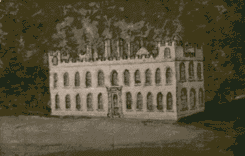Great Barr Hall (1777-1909)
A major reconstruction of Great Barr Hall occurred shortly after the marriage of Joseph Scott in 1777. He used the dowry brought to him by his bride, some £2000, to completely transform the building.
Stebbing Shaw in his "History and Antiquities of Staffordshire" notes:

". the present possessor about the year 1777 began to exercise his well known taste and ingenuity upon the old fabric, giving it the pleasing monastic appearance it now exhibits . and has since much improved it by the addition of a spacious dining room, at the East end, and other rooms and conveniences"
Mary Anne Schimmelpenninck, who lived at the Hall between 1785 and 1797 notes that:
"There were four or five different halls, and as many different staircases. It was more like an assemblage of several houses under the same roof, than the unity of one dwelling"
The South-West corner of the Hall was extended between 1800 and 1830.
Between 1830 and 1848 major re-construction of the Hall took place which included the addition of a clock tower. The South elevation of the Hall was extended, the entrance was moved to the North elevation, a building to the rear was demolished and the North and West elevations were extended.
Later in this period further extensions were added to the North and West elevations. A conservatory was also added to the South elevation.
In the period to 1863 a chapel was added to the South West corner of the Hall. This building is thought to have been designed by Sir Gilbert Scott, but the evidence for this is very flimsy. The chapel is not all it appears as it was never consecrated and was used as a billiards and trophy room.
Sir Gilbert Scott, not a relative of the Great Barr Scotts, definitely designed a pair of lodges in 1858—one still survives—and there is strong evidence he was also responsible for designing a wooden post bridge and two boathouses.
A collection of photographs by Sir Benjamin Stone taken around the turn of the century show that the Hall has remained unchanged since the chapel was added in 1863.
After the death of Lady Bateman-Scott in 1909 the Hall was purchased by West Bromwich Poor Law Guardians at auction..